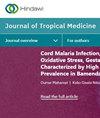Common Risk Factors for CD4 Cell Count and Hemoglobin Level among Female Adult HIV-Positive Patients: A Retrospective Longitudinal Study.
IF 2.1
4区 医学
Q3 PUBLIC, ENVIRONMENTAL & OCCUPATIONAL HEALTH
引用次数: 0
Abstract
Background HIV is one of the most significant worldwide health concerns of the twenty-first century and a serious threat to human society. Hemoglobin level and CD4 cell count are two of the most important biomarkers of HIV progression and patient survival. The objective of this study was to identify common risk factors associated with CD4 cell count and hemoglobin level among adult female HIV-positive patients treated with ART at the University of Gondar Comprehensive Specialized Hospital, Ethiopia. Methods The source of data in this study was secondary data conducted in the University of Gondar Comprehensive Specialized Hospital from September 2015 to March 2022 . Data exploration in this study was normal histogram plot, box plot, and Q-Q plot considered to gain some visions of the data related to CD4 cell count and hemoglobin level. A Bayesian joint model was used in this longitudinal data set to get a wide range of information about adult female HIV-patients. Results The mean with a standard deviation of hematocrit (%), red blood cell (106/μl), lymphocyte (%), and weight (kg) of female patients were 37.2 (3.8), 4.0 (1.6), 43.6 (11.8), and 44.9 (9.4), respectively. In this study, the random intercept model for CD4 cell count and the random intercept and slope model for hemoglobin level were considered as the best selected model. Visit time, hematocrit, weight, RBC, lymphocyte count, educational status, marital status, disclosure, and substance use were common risk factors for CD4 cell count and hemoglobin level. Conclusion This study concluded that, the risk factors visit time, weight, secondary educators, tertiary educators, married patients, patients who disclosed their HIV status to family members were associated with high CD4 cell count and hemoglobin level. While, hematocrit, RBC, lymphocyte count, separated marital status, widowed marital status, and substance-addicted patients were associated with low CD4 cell count and hemoglobin level. The author recommended that FMOH or other health professionals, program planners, decision makers, project implementers, government, and nongovernmental organizations should be given special attention for adult female patinets to minimize the risk of HIV progression and improve their health status. The author also recommended that health staff should conduct health-related studies for patients to examine continuous checkups. Health professionals also should give more attention to types of ART medication to reduce the progression of disease when the patients come back again into the hospital. Finally, adult female HIV-positive patients should be given special attention based on these important factors to improve their CD4 cell count, hemoglobin level, and better health quality.成年女性 HIV 阳性患者 CD4 细胞计数和血红蛋白水平的常见风险因素:一项回顾性纵向研究
背景艾滋病毒是二十一世纪全球最重要的健康问题之一,也是对人类社会的严重威胁。血红蛋白水平和 CD4 细胞计数是艾滋病进展和患者存活的两个最重要的生物标志物。本研究的目的是在埃塞俄比亚贡达尔大学综合专科医院接受抗逆转录病毒疗法治疗的成年女性 HIV 阳性患者中,确定与 CD4 细胞计数和血红蛋白水平相关的常见风险因素。方法本研究的数据来源是 2015 年 9 月至 2022 年 3 月在贡达尔大学综合专科医院进行的二手数据。本研究采用正态直方图、方框图和 Q-Q 图来探索 CD4 细胞计数和血红蛋白水平的相关数据。结果女性患者的血细胞比容(%)、红细胞(106/μl)、淋巴细胞(%)和体重(kg)的平均值和标准差分别为 37.2(3.8)、4.0(1.6)、43.6(11.8)和 44.9(9.4)。在本研究中,CD4 细胞计数的随机截距模型和血红蛋白水平的随机截距加斜率模型被认为是最佳选定模型。就诊时间、血细胞比容、体重、红细胞、淋巴细胞计数、教育状况、婚姻状况、信息披露和药物使用是影响 CD4 细胞计数和血红蛋白水平的常见风险因素。而血细胞比容、红细胞、淋巴细胞计数、分居婚姻状况、丧偶婚姻状况和药物成瘾患者与低 CD4 细胞计数和血红蛋白水平有关。作者建议,联邦卫生部或其他卫生专业人员、项目规划者、决策者、项目实施者、政府和非政府组织应特别关注成年女性患者,以最大限度地降低艾滋病恶化的风险,改善她们的健康状况。作者还建议,医护人员应为患者开展与健康相关的研究,以进行持续检查。医护人员还应更多地关注抗逆转录病毒疗法的药物种类,以减少患者再次入院时病情的发展。最后,应根据这些重要因素对成年女性艾滋病病毒阳性患者给予特别关注,以提高她们的 CD4 细胞计数、血红蛋白水平和健康质量。
本文章由计算机程序翻译,如有差异,请以英文原文为准。
求助全文
约1分钟内获得全文
求助全文
来源期刊

Journal of Tropical Medicine
Immunology and Microbiology-Parasitology
CiteScore
3.90
自引率
4.50%
发文量
0
审稿时长
14 weeks
期刊介绍:
Journal of Tropical Medicine is a peer-reviewed, Open Access journal that publishes original research articles, review articles, and clinical studies on all aspects of tropical diseases. Articles on the pathology, diagnosis, and treatment of tropical diseases, parasites and their hosts, epidemiology, and public health issues will be considered. Journal of Tropical Medicine aims to facilitate the communication of advances addressing global health and mortality relating to tropical diseases.
 求助内容:
求助内容: 应助结果提醒方式:
应助结果提醒方式:


